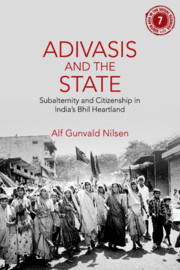Book contents
- Frontmatter
- Dedication
- Contents
- List of Maps, Figures, and Tables
- Glossary of Hindi Terms
- Preface
- 1 Introduction
- Part I Subalternity
- 2 ‘So Much Fear Was Inside Us’: Everyday Tyranny in the Bhil Heartland
- 3 ‘Quiet and Obedient Cultivators’: Colonial State Space and the Origins of Everyday Tyranny
- 4 ‘You Are Now the Masters of the Country’: Negotiations and Consolidations
- Part II Citizenship
- Bibliography
- Index
2 - ‘So Much Fear Was Inside Us’: Everyday Tyranny in the Bhil Heartland
from Part I - Subalternity
Published online by Cambridge University Press: 01 November 2018
- Frontmatter
- Dedication
- Contents
- List of Maps, Figures, and Tables
- Glossary of Hindi Terms
- Preface
- 1 Introduction
- Part I Subalternity
- 2 ‘So Much Fear Was Inside Us’: Everyday Tyranny in the Bhil Heartland
- 3 ‘Quiet and Obedient Cultivators’: Colonial State Space and the Origins of Everyday Tyranny
- 4 ‘You Are Now the Masters of the Country’: Negotiations and Consolidations
- Part II Citizenship
- Bibliography
- Index
Summary
If there is one thing that defines Adivasi subalternity in contemporary India, it is chronic and abject poverty. At the national level, it has been estimated that 44.7 per cent of India's Adivasis lived below the poverty line in 2011; while constituting only 8 per cent of India's total population, they make up as much as 25 per cent of the poorest decile of this population. Conversely, altogether 30 per cent of India's Adivasis are located in the poorest decile of the country's population. Scheduled Tribes (STs) also registered far lower levels of poverty reduction than the non-ST population between the early 1980s and 2004–2005 (Mehta, Shepherd, Bhide, and Shah 2011; World Bank 2011). As Maharatna (2005: 73) points out, the depth of Adivasi poverty is particularly evident in terms of basic social development indicators, which suggest that ‘the tribal population is even worse off than their [Scheduled Caste] counterparts, especially in terms of healthcare and basic education. In fact, tribals … are the most deprived section so far as the distribution of infrastructural facilities and provisions of basic amenities … is concerned’. In other words, Adivasis can rightly be described as one of the groups who ‘have gained least and lost most from six decades of democracy and development in India’ (Guha 2007b: 3309).
This national pattern is easily identified among the Adivasis of Madhya Pradesh. Whereas an average of 38 per cent of the state's population lived below the poverty line in 2004–2005, the same is true for 58.6 per cent of STs in Madhya Pradesh (see Ray et al. 2009: 64). In the districts of western Madhya Pradesh which are home to the Bhils who are the focus of attention in this book, poverty rates among Adivasis are not only higher than among non-Adivasis, but have also increased quite significantly in recent years (Shah and Sah 2003, 2004).’
Furthermore, across the central Indian tribal belt, stretching from Gujarat and Maharashtra in the west to Jharkhand and Orissa in the east, poverty rates among Adivasis are also disproportionately high: in India as a whole, every fourth person lives in poverty, but in the tribal areas of Madhya Pradesh, Gujarat, Rajasthan, Chhattisgarh, Jharkhand, and Orissa, two out of every three persons suffer this fate.
- Type
- Chapter
- Information
- Adivasis and the StateSubalternity and Citizenship in India's Bhil Heartland, pp. 29 - 58Publisher: Cambridge University PressPrint publication year: 2018



